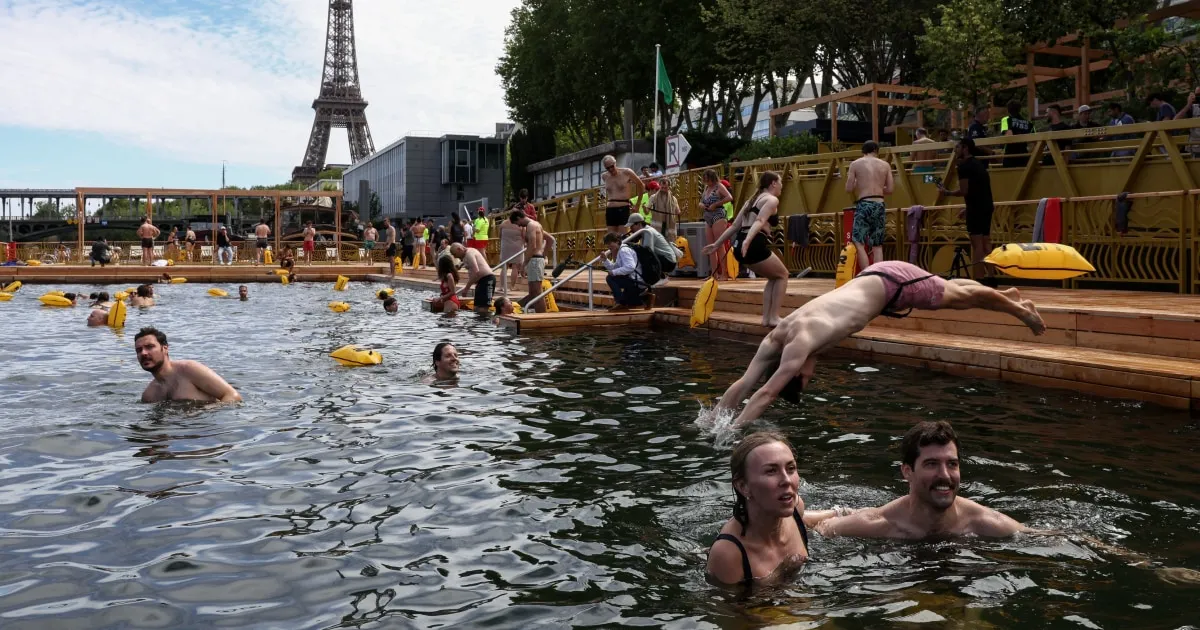
On Saturday morning, cries of “It is warm!” resonated across the iconic Seine River as Parisians took a plunge into its waters legally for the first time in over a century. This monumental event marked a significant turnaround for public swimming in the Seine, officially allowed in designated areas which include two newly constructed wooden decks located near the Eiffel Tower and the picturesque Île Saint-Louis in central Paris.
Before dawn broke, a dedicated municipal officer diligently skimmed the last remnants of algae from the surface using a fishnet, ensuring the swimming areas were clean and inviting. As the sun began to rise, a queue of eager Parisians formed, towels in hand, eagerly awaiting their moment to dive into the emerald-green waters. Joyful woos and cries filled the air as the first swimmers braved the cool waters, their bright yellow lifebuoys securely tied around their waists. This safety measure, enforced by a team of a dozen lifeguards clad in high-visibility vests, ensured a safe experience for all participants.
The current in the river was gentle, providing just enough of a tug to remind swimmers that they were in a vibrant urban river. “It’s so nice to swim in the heart of the city, especially with the high temperatures we’ve been having lately,” shared Amine Hocini, a 25-year-old construction worker from Paris. His enthusiasm was palpable as he remarked, “I’m surprised because I thought it was going to be cooler, and in fact, it’s much warmer than I thought.”
This return to swimming is a direct result of a substantial 1.4 billion euro ($1.5 billion) cleanup initiative linked to last year’s Olympic preparations. City officials now confidently assert that the Seine meets European water quality standards on most days, making this a historic moment for the city. Mayor Anne Hidalgo, who took a dip in the river last year, was present on Saturday morning, showcasing her confidence by holding up a transparent bottle filled with Seine water. Environmental authorities confirmed that bacteria levels in the water were well below official thresholds, further reassuring swimmers.
Swimming in the Seine had been prohibited since 1923, primarily due to pollution and the dangers associated with river navigation. Although swimming outside designated bathing areas remains illegal for safety reasons, the atmosphere along the river was electric. Tourists and morning joggers paused to watch the spectacle, with some applauding as swimmers ascended the steel ladders, beaming and dripping with joy. However, not everyone shared the enthusiasm. François Fournier, a local resident, expressed his skepticism while observing from a bridge. “I won’t risk it quite frankly,” he stated. “I’ve seen things you can’t imagine floating in the Seine, so I’ll wait for it to be really squeaky clean.”
While floating debris, such as stray leaves and plastic wrappers, occasionally disrupted the surface, the smell of the river was barely noticeable. Gone were the strong odors of sewage; instead, an earthy, river-like scent prevailed. “This is so chic, to swim in the Seine, next to Île Saint-Louis,” remarked Lucile Woodward, a 43-year-old local resident. She acknowledged the natural apprehensions that come with swimming in open water but expressed trust in the thorough testing that had been conducted. “I don’t think the town hall can allow herself to have any problems,” she added with a laugh, reassuringly stating, “My skin is OK.”
The historic opportunity for public swimming in the Seine marks a significant cultural shift for Paris, blending the city's rich history with modern environmental efforts. As more Parisians and visitors embrace this newfound freedom, the Seine is set to become a symbol of a cleaner, more accessible urban experience.